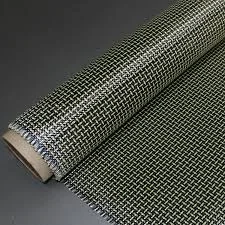In recent years, there has been a growing global emphasis on renewable energy technologies as a means to combat climate change and reduce reliance on fossil fuels. One critical component in the development of renewable energy technologies is the use of advanced materials that can withstand the demanding conditions of these applications. Unidirectional carbon fiber fabric has emerged as a vital material in various renewable energy technologies due to its exceptional strength, lightweight nature, and durability. In this blog post, we will explore the role of unidirectional carbon fiber fabric in renewable energy technologies and highlight the innovative solutions provided by Hengzhong, a leading company in the carbon fiber industry.
Understanding Unidirectional Carbon Fiber Fabric
Unidirectional carbon fiber fabric is composed of carbon fibers aligned parallel to each other and impregnated with a resin matrix. This orientation of the fibers provides the fabric with exceptional strength and stiffness along a single direction, making it ideal for applications where high tensile strength and load-bearing capabilities are required. The carbon fibers themselves are incredibly thin, with a diameter of only a few micrometers, yet they possess remarkable mechanical properties that surpass those of traditional materials like steel or aluminum.

Unidirectional Carbon Fiber Fabric in Renewable Energy Technologies
1.Wind Turbine Blades: Unidirectional carbon fiber fabric plays a crucial role in the manufacturing of wind turbine blades, which are essential components of wind energy systems. These blades need to withstand high wind speeds, extreme temperatures, and constant cyclic loading. The exceptional strength and lightweight nature of unidirectional carbon fiber fabric make it an ideal choice for constructing wind turbine blades that can efficiently convert wind energy into electricity. The use of carbon fiber composites in wind turbine blades allows for longer, lighter, and more durable blades, improving the overall efficiency and performance of wind energy systems.
2.Solar Panels: Solar panels are another important renewable energy technology that benefits from the use of unidirectional carbon fiber fabric. Solar panels consist of photovoltaic cells that convert sunlight into electricity. Unidirectional carbon fiber fabric is used in the construction of solar panel frames and supports, providing structural integrity and durability. The lightweight nature of carbon fiber composites allows for easy installation and transportation of solar panels. Additionally, carbon fiber composites offer excellent resistance to corrosion and degradation, ensuring the longevity and reliability of solar panel systems.
3.Hydroelectric Systems: Unidirectional carbon fiber fabric finds applications in hydroelectric systems, which generate electricity through the force of flowing or falling water. Components such as turbine blades, rotor shafts, and guide vanes require materials with high strength and resistance to corrosion. Unidirectional carbon fiber fabric, with its exceptional mechanical properties and resistance to moisture, provides an ideal solution for these components. By incorporating carbon fiber composites into hydroelectric systems, the efficiency and reliability of these systems can be enhanced, contributing to the sustainable production of electricity.
4.Energy Storage: Unidirectional carbon fiber fabric also plays a role in energy storage technologies, such as battery systems. Battery casings and components require materials that can withstand high pressures, temperature fluctuations, and chemical exposure. Unidirectional carbon fiber fabric, with its high strength-to-weight ratio and resistance to corrosion, offers an excellent solution for creating lightweight and durable battery enclosures. By utilizing carbon fiber composites in energy storage systems, the overall efficiency and safety of these technologies can be improved.
Hengzhong: Innovating with Unidirectional Carbon Fiber Fabric
Hengzhong is a leading company in the carbon fiber industry, offering innovative solutions for various applications, including renewable energy technologies. With a commitment to research and development, Hengzhong specializes in the production of high-quality unidirectional carbon fiber fabric.
Hengzhong's unidirectional carbon fiber fabric is engineered to provide exceptional mechanical properties, such as high tensile strength, stiffness, and fatigue resistance. Their advanced manufacturing processes ensure consistent quality and uniformity in the fabric, enabling precise and reliable performance in renewable energy applications.

Conclusion
Unidirectional carbon fiber fabric is a critical material in the development of renewable energy technologies. Its exceptional strength, lightweight nature, and durability make it an ideal choice for various applications, including wind turbine blades, solar panels, hydroelectric systems, and energy storage. Hengzhong, a renowned company in the carbon fiber industry, offers innovative solutions with their high-quality unidirectional carbon fiber fabric. By embracing the potential of carbon fiber composites, we can drive the advancement of renewable energy technologies, contributing to a more sustainable and greener future.






